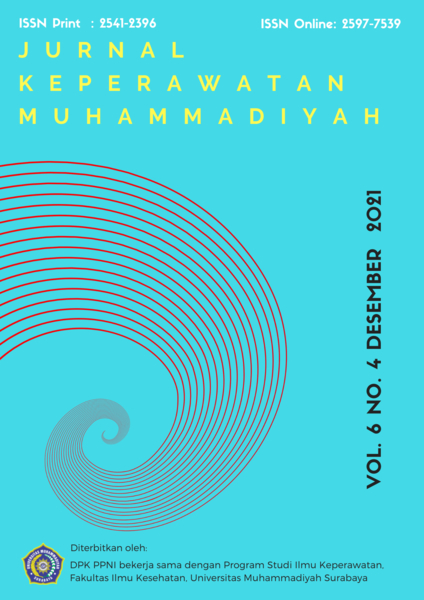Profil Faktor Risiko Stroke Tenaga Keperawatan RSI Fatimah Cilacap
DOI:
https://doi.org/10.30651/jkm.v6i4.10447Kata Kunci:
Stroke, faktor risiko, tenaga keperawatanAbstrak
Research objective: The research objective is to examine and provide information about the risk factors for stroke in nursing staff. Research method: The study was conducted on 147 nursing staff, the research design was quantitative observational with a cross sectional approach using a Stroke Risk Scorecard questionnaire. The analysis of the results was carried out using a description method that produced a percentage.  Results: The results obtained are the risk of stroke by nursing staff at RSI Fatimah
in a low level of 63.9%, a warning of 21.8% and a high risk of 14.3%. Nursing staff with a high risk of stroke are in the age range of 26-35 years. Conclusion: The conclusion of the study is that most of the nursing staff at RSI Fatimah Cilacap are at low risk and can control stroke well.Referensi
Abete, I. et al. (2018) ‘Association of lifestyle, inflammatory factors, and dietary patterns with the risk of suffering a stroke: A case–control study’, Nutritional Neuroscience, 21(1), pp. 70–78. doi:10.1080/1028415X.2016.1226473.
Aigner, A. et al. (2018) ‘Low diet quality and the risk of stroke mortality: the multiethnic cohort study’, European Journal of Clinical Nutrition, 72(7), pp. 1035–1045. doi:10.1038/s41430-018-0103-4.
Boehme, A.K., Esenwa, C. and Elkind, M.S.V. (2017) ‘Stroke Risk Factors, Genetics, and Prevention’, Circulation Research, 120(3), pp. 472–495. doi:10.1161/CIRCRESAHA.116.308398.
Courand, P.-Y. et al. (2018) ‘Recurrent vertigo is a predictor of stroke in a large cohort of hypertensive patients’, Journal of Hypertension, 36(1), p. 7.
Department of Physiology, Faculty of Medicine and Health Sciences, Universitas Muhammadiyah Yogyakarta et al. (2020) ‘Relationship between Demographic Factors and Body Mass Index with the Prevention of Hypertension in Adolescents’, Journal of Health Promotion and Behavior, 5(2), pp. 72–78. doi:10.26911/thejhpb.2020.05.02.01.
Hackshaw, A. et al. (no date) ‘Low cigarette consumption and risk of coronary heart disease and stroke: meta-analysis of 141 cohort studies in 55 study reports’, p. 16.
Howard, V.J. and McDonnell, M.N. (2016) ‘Physical Activity in Primary Stroke Prevention’, p. 5.
Katan, M. and Luft, A. (2018) ‘Global Burden of Stroke’, Seminars in Neurology, 38(02), pp. 208–211. doi:10.1055/s-0038-1649503.
Kroll, M.E. et al. (2016) ‘Adiposity and ischemic and hemorrhagic stroke’, p. 9.
Kuswandono, E. (2019) ‘HUBUNGAN PERILAKU OLAHRAGA TERHADAPHIPERTENSIPADA LANSIADIPUSKESMAS SIDOMULYOPEKANBARU’, 1, p. 6.
Lau, L. et al. (2019) ‘Prevalence of diabetes and its effects on stroke outcomes: A metaâ€analysis and literature review’, Journal of Diabetes Investigation, 10(3), pp. 780–792. doi:10.1111/jdi.12932.
Maulida, M., Mayasari, D. and Rahmayani, F. (no date) ‘Pengaruh Rasio Kolesterol Total terhadap High Density Lipoprotein (HDL) pada Kejadian Stroke Iskemik’, p. 5.
Milojevic Samanovic, A. et al. (2019) ‘The Factors Associated with the Fatal Outcome of Stroke’, Serbian Journal of Experimental and Clinical Research, 0(0). doi:10.2478/sjecr-2019-0014.
Oladiran, O. and Nwosu, I. (2019) ‘Stroke risk stratification in atrial fibrillation: a review of common risk factors’, Journal of Community Hospital Internal Medicine Perspectives, 9(2), pp. 113–120. doi:10.1080/20009666.2019.1593781.
Pan, B. et al. (2019) ‘The relationship between smoking and stroke: A meta-analysis’, Medicine, 98(12), p. e14872. doi:10.1097/MD.0000000000014872.
Park, H.J. et al. (2015) ‘Family History and Functional Outcome in Korean Stroke Patients: A Preliminary Study’, Annals of Rehabilitation Medicine, 39(6), p. 980. doi:10.5535/arm.2015.39.6.980.
Richards, E.A. and Cai, Y. (2016) ‘Physical Activity Outcomes of Nurse-Delivered Lifestyle Interventions’, Home Healthcare Now, 34(2), pp. 93–101. doi:10.1097/NHH.0000000000000334.
Rutten-Jacobs, L.C. et al. (2018) ‘Genetic risk, incident stroke, and the benefits of adhering to a healthy lifestyle: cohort study of 306 473 UK Biobank participants’, BMJ, p. k4168. doi:10.1136/bmj.k4168.
Shang, Y. et al. (2020) ‘Association of diabetes with stroke and postâ€stroke dementia: A populationâ€based cohort study’, Alzheimer’s & Dementia, 16(7), pp. 1003–1012. doi:10.1002/alz.12101.
Son, M.K. et al. (2017) ‘Risk of ischemic stroke after atrial fibrillation diagnosis: A national sample cohort’, PLOS ONE. Edited by N.H. Bishopric, 12(6), p. e0179687. doi:10.1371/journal.pone.0179687.
Srywahyuni, A. et al. (2019) ‘USING SCORECARD TO ANALYSE RISK FACTORS OF STROKE IN WEST SUMATERA INDOENSIA’, (4), p. 7.
Sultradewi Kesuma, N.M.T., Krismashogi Dharmawan, D. and Fatmawati, H. (2019) ‘Gambaran faktor risiko dan tingkat risiko stroke iskemik berdasarkan stroke risk scorecard di RSUD Klungkung’, Intisari Sains Medis, 10(3). doi:10.15562/ism.v10i3.397.
Zheng, G. et al. (2015) ‘Tai Chi Chuan for the Primary Prevention of Stroke in Middle-Aged and Elderly Adults: A Systematic Review’, Evidence-Based Complementary and Alternative Medicine, 2015, pp. 1–18. doi:10.1155/2015/742152.
Unduhan
Diterbitkan
Terbitan
Bagian
Lisensi
- Penulis tetap memegang hak atas karyanya dan memberikan hak publikasi pertama kepada jurnal ini yang secara simultan karya tersebut dilisensikan di bawah:Â Creative Commons Attribution-ShareAlike 4.0 International (CC BY-SA 4.0)









